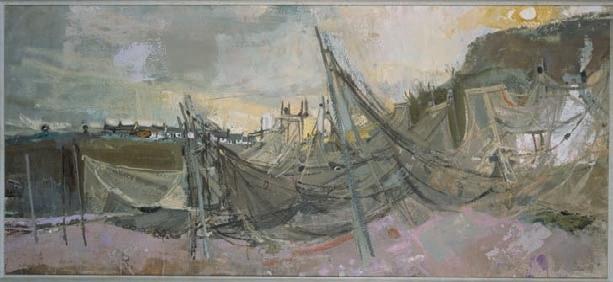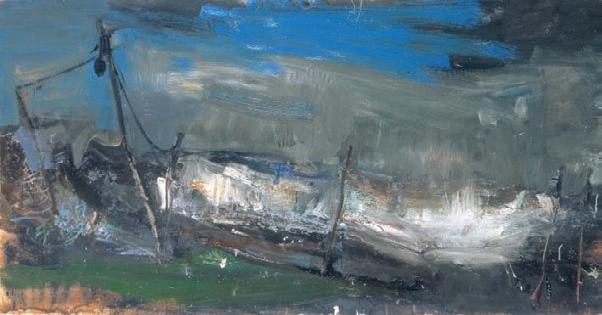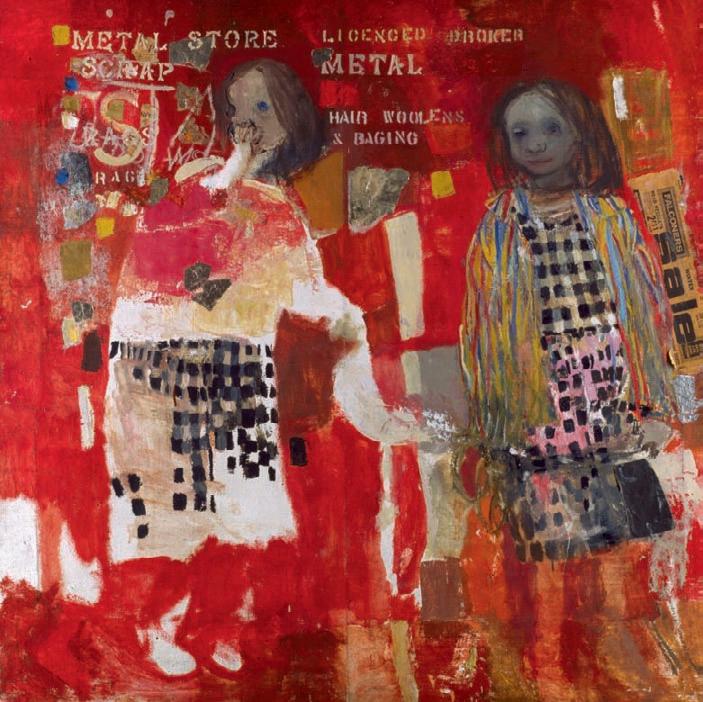




Joan Kathleen Harding Eardley was born on 18 May 1921 at Bailing Hill Farm at Warnham in Sussex, the fi rst child of Captain William Eardley and his wife Irene (née Morrison).1 The couple had met during the First World War when Captain Eardley was stationed at Maryhill Barracks in Glasgow, and they married at the end of the war. He had been gassed in France and suffered from depression as a result. Following the failure of his dairy farm in Sussex, Captain Eardley found work with the Ministry of Agriculture. In 1926 Irene Eardley took her two daughters, Joan and Pat (born in 1922), to live in Blackheath in London with her mother Ellen and her sister Sybil Morrison. Joan and Pat went to Oakland House Primary School and then to St Helen’s School, paid for by prosperous great-aunts, and there the art teacher Miss Waddland spotted Joan’s talent [4] . Three years after this move, Eardley’s father committed suicide; the nature of his death was not explained to Joan and Pat until much later. Although Joan inherited her father’s tendency to depression, she thrived in the all-female household in Blackheath where her mother was a constant source of support in her quest to become an artist. Joan was also devoted to her grandmother and to her aunt Sybil, a leading light in the Peace Pledge Union, whose belief in women’s rights exerted a lasting influence upon Joan.
Joan left St Helen’s in the spring of 1938 and had two terms at the local art school in Blackheath. In the autumn of 1938 she enrolled at Goldsmiths College in London and also spent two terms there.
In 1939, the family moved away from London and returned to Scotland where they stayed with a relative in Auchterarder before moving to a house at 170 Drymen Road in the Glasgow suburb of Bearsden in January 1940. The timing of the move to Scotland meant that Joan Eardley entered Glasgow School of Art in the sec-
ond term, in January 1940. Her fellow student, Margot Sandeman remembers Eardley arriving with a formal, permed hairstyle but recalled that Eardley soon relaxed and became her own down-to-earth self, uninterested in fashion and obsessed by her work. 2 Eardley and Sandeman [6] , who also lived in Bearsden, soon began a lifelong friendship, a relationship which was to be the most important of Eardley’s life. During the next two years Eardley completed the General Course at Glasgow School of Art. From 1942 to 1943 she took the diploma course in drawing and painting but her war work as a joiner’s labourer meant that she was registered as an evening student specialising in life drawing.3
In 1940 the Principal of Glasgow School of Art was the portrait painter William Oliphant Hutchison, while the Head of Painting was Hugh Adam Crawford. Ian Fleming taught History of Art. Hutchison left in 1943 and in his last Director’s report, he singled out Eardley: ‘The Painting School gave the impression of great liveliness, led by remarkably powerful and colourful work by a woman student.’4 Eardley, in fact, had already come to wider notice. In May 1940, reviewing Glasgow School of Art’s end-of-year exhibition the art critic of the Glasgow Herald noted: ‘The most interesting picture is called ‘Street Scene’. It is by a first year student and has a fine robust confidence about it. There is a sense of personality in the figure of a boy sitting straddle on a chair, playing with a dog, with the rest of the family in the background.’5 Other early student works include The Rush Hour [12] a bustling street scene full of flying figures, and Noah’s Ark, done in modern dress and bright colours. In both compositions the figures are simple and sturdy. It seems that Eardley was really striving to come to grips with movement and tone in The Rush Hour and formal composition and colour experiments in Noah’s Ark.
In 1942 Eardley exhibited Woman with a Shawl with the Society of Scottish Artists in Edinburgh. It may be
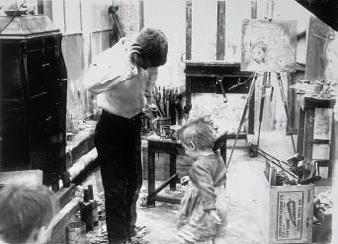
these things don’t bring happiness.’ 40 Furthermore, from the mid–1950s due to a slipped disc, she had to contend with back pain for the rest of her life and painted wearing a neck brace.
Eardley was very fond of Angus Neil. He had developed mental health problems after the war, and, although Eardley had no illusions about his temperamental and sometimes untrustworthy nature, they were close companions. He often posed for her. In A Glasgow Lodging he is shown as a lonely figure swamped in an army greatcoat by the fire, while in The Table [33] he is in a kitchen lit by strong shafts of colour. Sandeman recalls that when Angus took money or crossed other boundaries, Eardley would literally come to blows with him.41 But Neil was a very patient model. In Sleeping Nude [34] , which was likened at the time to a Belsen victim, the sombre grey palette-knife technique recalls that of Nicolas de Staël, whose work was shown in Edinburgh in 1954. Eardley was subjected to ‘shock horror’ headlines in the tabloid press on showing this work. One newspaper printed her address, whereupon various men turned up volunteering to pose for her. Eardley never again painted a male nude. Ironically, it was Angus Neil who protected Eardley from unwelcome attention when she went sketching in some of the roughest areas of Glasgow. He also helped with difficult joinery tasks and offered a barrier to the outside world by the very fact of his existence as a male friend.
34 | glasgow and childhood
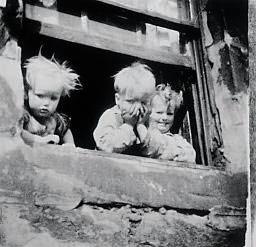

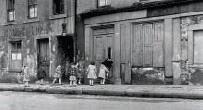

30 | Photograph of children at a window, used by Joan Eardley as source material for her paintings
Photo: Joan Eardley
Joan Eardley archive, Scottish national Gallery of Modern art, Edinburgh [gma/ao9]
31a–c | Street scenes, Rottenrow, Glasgow, showing children exploring a bomb-damaged building
Photo: Audrey Walker post 1952
Joan Eardley archive, Scottish national Gallery of Modern art, Edinburgh [gma/ao9]
Eardley’s view of impoverished tenement life was seen south of the border in London in 1954 when she exhibited at a group show at The Parsons Gallery in Grosvenor Street. A press photograph shows Eardley hanging pictures of Angus Neil alongside her vivid head studies of boys [45–7, 90] . A notice in the Glasgow Herald described how Eardley’s work was ‘concerned with scenes and people of working-class Glasgow, the back streets and tenements in the neighbourhood of her studio … they are social documents literal enough to please the most exacting realist … her portraits of children … a combination of skill, acute observation and sympathetic truth’.42 During the early years of the war thousands of children had been evacuated from Glasgow and the terrible blitz on Clydebank in March 1941 had, besides killing many children and civilians, left much of the population
homeless. In the postwar rebuilding of Glasgow new areas of housing such as Castlemilk provided hitherto unknown modern facilities for working-class families and Basil Spence’s tower blocks in the Gorbals were a brave new world until the reality of leaking roofs, damp, and broken lifts would lead to disillusion in the sixties. In this push to modernise Glasgow, the city councillors were not always keen to see Eardley’s depictions of the urban underclass.
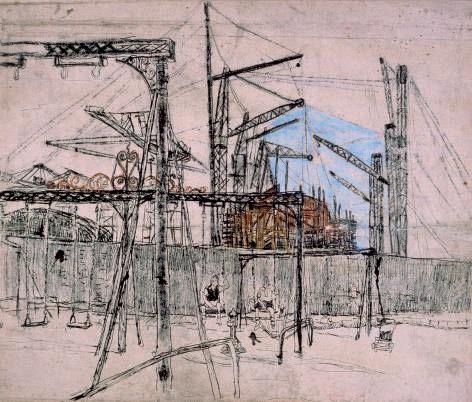
Eardley painted a considerable number of seascapes. She usually painted on hardboard, using not only artist’s paint but also boat paint, with newspaper, sand and grasses embedded in the mixture. She used a palette knife to create texture, dribbled paint down the foreground, and used the end of her brush to draw into the wet surface. Big, grey seascapes were enlivened with bold touches of colour. Light on the water or breaking through stormy skies created visual highlights. The mood is brighter in works such as Foam and Blue Sky [69] , the luscious rsa diploma work Summer Sea [1] and the creamy, boiling sea of Flood Tide [70] . The dark, winter seas can be seen in Winter Sea III [68] and in The Sea [67] . In contrast, Wave Study II [71] is a gestural semi-abstract composition in yellow and orange that lifts the spirits. But the full majesty of the sea is embodied in The Wave [66] with its almost architectural form of a wall of foaming water poised before crashing to the shore. To paint these seacapes, Eardley would have stood on the shoreline in the bay at
Catterline. One of Audrey Walker’s photographs shows her with her board held down by rocks facing the boiling sea [53] . The only colour photograph of Eardley, also taken by Walker [frontispiece] , shows her on a summer’s day seated on a shooting stick actually in the sea, with her sketchbook facing the shore where the salmon nets, a subject that Eardley returned to in several works, were hung to dry on the makin’ green. Drying Salmon Nets [56] is a tightly composed work with colours which evoke a winter’s day. A later work, the majestic Salmon Net Posts [57], is a much larger, semi-abstract composition that looks from the salmon net posts out to sea. Considering the massive size of the biggest seascapes, some were two metres wide, it is amazing that Eardley was able to manhandle these huge boards up and down the steep cliff path. However, thanks to the acquisition of a motor scooter, she could trundle her materials to and fro, and catch the train to Glasgow at Stonehaven [92] . Eardley commuted backwards and forwards between Glasgow
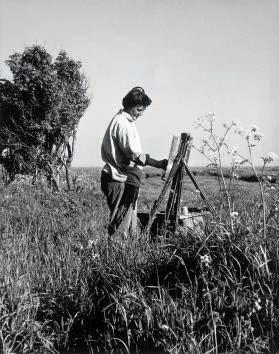
52
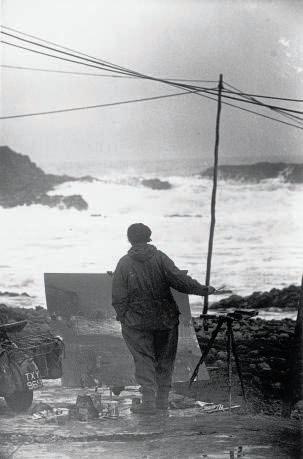
Photo: Audrey Walker
dumfriesshire Educational Trust, Gracefield art Centre, dumfries
53 | Eardley painting facing the sea on the shore at Catterline, c.1950s
Photo: Audrey Walker
Joan Eardley archive, Scottish national Gallery of Modern art, Edinburgh [gma/ao9]
and Catterline and a phone call from a neighbour at Catterline warning of approaching storms would send Eardley racing north again.
In 1955 Eardley bought Number 1 The Row, Catterline [54] , which was a shell of a house with no floor, ceiling or sanitation. Eardley and Neil made it weather-tight, laid bark chippings on the floor and pinned up sail-cloths for walls and ceiling. Here, from her own front door, she often painted the shore line, with its jetty and the prominent rock stacks. At some point in the mid–1950s she lived at Sarah’s Cottage, named after a previous resident, which was away from the cliff top but then in 1959 came the chance to purchase Number 18, Catterline. This house, which was in good order and had plumbing, faced the sea from the cliff top. A photograph by her friend, the Glasgow photographer, Oscar Marzaroli, shows Eardley, Angus Neil and Eardley’s final protégée, the painter Lil Neilson outside Number 18, Catterline [55]
Eardley was greatly attached to the local community
and to the countryside around Catterline. Her taped interview is worth quoting at length:
‘When I’m painting in the north east – I hardly ever move out of the village. I hardly ever move from one spot. I find the more I know the place, the more I know the particular spot, the more I find to paint in that particular spot … I do feel the more you know something the more you can get out of it – the more it gives you … I think I am painting what I feel about scenery – but certainly not scenery with a name because that is the north east – it’s just a vast waste, vast seas, vast areas of cliff – all these areas for painting. I very often find I’ll take my paints to a certain place that has moved me and I’ll begin to paint there and I find perhaps by the end of the summer I haven’t moved from that place – my paintings are still there and I’ve worn a kind of mark in the ground and I leave my paints there overnight and I seem to build up a sort of table and … a studio seems to have arrived outside and that seems to be how I work. Once I start in a
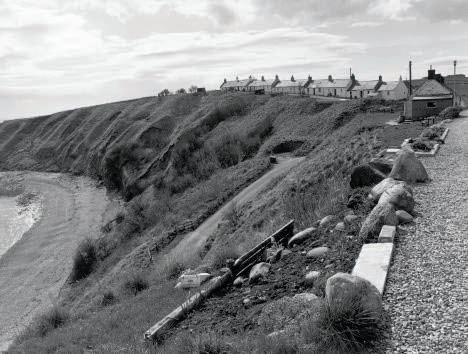
place I find I don’t want to move because I’m trying to do something and you are never really satisfied with what you’re doing and so you keep on trying and the more you try the more you think of new ways to do this particular subject so you just go on and on or you might just turn round in the middle of doing a certain painting and you see something else and you run back and get another canvas and try and do that but its still the same spot really and obviously the feeling you are trying to grasp has such terrific clarity and light … I think you’ve got to know something before you paint it …’47
Another popular subject was the beehives in the back garden area on the edge of the cliff at Number 1, which Eardley painted during different seasons, in various weathers and at different times of the day [58, 88] . This sort of serial painting had something in common with Monet, and like Monet she also painted a series of paintings of haystacks, probably in the fields behind The Row [52] . The fields behind The Row became the setting for many lyrical paintings, for example Summer Fields [60] , Harvest [61] , Seeded Grasses and Daisies, September [62] , which incorporated a collage of real grasses and daisies set against a sombre sky , and Field and Birds [59] . She also recorded the fields behind The Row in winter, in paintings such as Snow [63] and the leaden-skied view of the front of The Row in one of her best-loved works, Catterline in Winter [51].
The small community at Catterline was periodically expanded by Eardley’s friends, including Angus Neil.
In 1960 when teaching at Hospitalfield, Eardley met the young painter Lil Neilson, a graduate of Duncan of Jordanstone College of Art in Dundee. Neilson came to live in Catterline in September 1962 but left in December in order to work in the theatre. Neilson and Eardley maintained contact and at the beginning of 1963 Eardley managed to secure the use of Number 6 The Row, Catterline for Neilson.
Although spending most of her time after 1956 painting seascapes and landscapes at Catterline, Eardley remained in touch with Margot Sandeman. Their friendship gave them the opportunity to discuss the many issues they both faced as professional artists. Every two years they went to London to stay with Eardley’s aunt, Sybil Morrison, to see exhibitions and visit museums. Sandeman was married to the potter James Robson, and had two children. She stopped painting while the children were small but resumed in the 1970s. Eardley’s other main confidante was Audrey Walker whom she had met in 1952. She also had a family to bring up, as well as supporting her husband Sheriff Allan Walker in his life as a public official in Glasgow and Lanarkshire. The couple’s invitations to Eardley to stay at their country home at Caverslea in Selkirkshire led to a series of drawings and paintings of sheep-shearing. Walker was a gifted violinist as well as a photographer. Eardley herself liked classical music – by composers such as Bach, Britten and Bartok – and latterly the jazz music of John Coltrane.48 After art, music was her principal love.

56 | Drying Salmon Nets, 1956 oil on canvas 71.1 x 154.9cm
57 | Salmon Net Posts, 1962 oil on board 118.5 x 217.5cm Tate, Presented by the Friends of the
1986
